δ-MnO2 Drives the Green Decomposition of Arsenopyrite by Mediating the Fate of Arsenic to Generate FeAsO4
Abstract
:1. Introduction
2. Materials and Methods
2.1. Minerals and Particle Preparation
2.2. Preparation of δ-MnO2 Nanoparticles and Their Characterization
2.3. Experimental Procedure
2.4. Analytical Method
3. Results and Discussion
3.1. Oxidative Dissolution of Arsenopyrite Mediated by δ-MnO2
3.2. Changes in the Morphology and Mineralogical Phase during the Oxidative Dissolution of Arsenopyrite
3.3. Speciation Transformation of As, Fe and S during Oxidative Dissolution of Arsenopyrite
3.4. Mechanisms of Arsenopyrite Oxidative Dissolution and Arsenic Immobility Mediated by δ-MnO2
4. Conclusions
- i.
- δ-MnO2, as a strong oxidant, could oxidize arsenopyrite under acid conditions, while controlling arsenic release.
- ii.
- The addition of δ-MnO2 significantly altered arsenic precipitation and the solution’s chemistry, thereby influencing the fate of arsenic.
- iii.
- The addition of δ-MnO2 significantly accelerated the oxidation dissolution of arsenopyrite, and the formation of amorphous ferric arsenate, which is advantageous for the immobilization of arsenic.
- iv.
- The addition of an increased amount of δ-MnO2 (≥5 g/L) resulted in a significant increase in the solution pH, and the iron and arsenic concentrations decreased to almost zero. Small amounts of elemental sulfur and large amounts of amorphous ferric arsenate formed a porous structure on the surface of the mineral precipitate. Consequently, the dissolution of arsenopyrite continued, and the released arsenic was completely precipitated.
- v.
- δ-MnO2 rapidly oxidized As(III) and Fe2+ on the adsorbed surface to As(V) and Fe3+, and As(V) and Fe3+ further rapidly generated amorphous ferric arsenate precipitates.
Author Contributions
Funding
Data Availability Statement
Acknowledgments
Conflicts of Interest
References
- Mudd, G.M. Global trends in gold mining: Towards quantifying environmental and resource sustainability. Resour. Policy 2007, 32, 42–56. [Google Scholar] [CrossRef]
- Corkhill, C.L.; Vaughan, D.J. Arsenopyrite oxidation—A review. Appl. Geochem. 2009, 24, 2342–2361. [Google Scholar] [CrossRef]
- Gonzalez, R.; Gentina, J.C.; Acevedo, F. Biooxidation of a gold concentrate in a continuous stirred tank reactor: Mathematical model and optimal configuration. Biochem. Eng. J. 2004, 19, 33–42. [Google Scholar] [CrossRef]
- Nan, X.Y.; Cai, X.; Kong, J. Pretreatment Process on Refractory Gold Ores with As. Isij Int. 2014, 54, 543–547. [Google Scholar] [CrossRef]
- Akcil, A.; Ciftci, H. Pretreatments Applied to Refractory Gold Ores. Madencilik 2009, 48, 17–30. [Google Scholar]
- Koslides, T.; Ciminelli, V.S.T. Pressure oxidation of arsenopyrite and pyrite in alkaline solutions. Hydrometallurgy 1992, 30, 87–106. [Google Scholar] [CrossRef]
- Michelis, I.D.; Olivieri, A.; Ubaldini, S.; Ferella, F.; Beolchini, F.; Vegliò, F. Roasting and chlorine leaching of gold-bearing refractory concentrate: Experimental and process analysis. Int. J. Min. Sci. Technol. 2013, 23, 709–715. [Google Scholar] [CrossRef]
- Bowden, W.; Grey, C.P.; Hackney, S.; Wang, F.; Paik, Y.; Iltchev, N.; Sirotina, R. Lithiation of ramsdellite–pyrolusite MnO2; NMR, XRD, TEM and electrochemical investigation of the discharge mechanism. J. Power Sources 2006, 153, 265–273. [Google Scholar] [CrossRef]
- Ouvrard, S.; Donato, P.D.; Simonnot, M.O.; Begin, S.; Ghanbaja, J.; Alnot, M.; Duval, Y.B.; Lhote, F.; Barres, O.; Sardin, M. Natural manganese oxide: Combined analytical approach for solid characterization and arsenic retention. Geochim. Cosmochim. Acta 2005, 69, 2715–2724. [Google Scholar] [CrossRef]
- Dawadi, S.; Gupta, A.; Khatri, M.; Budhathoki, B.; Lamichhane, G.; Parajuli, N. Manganese dioxide nanoparticles: Synthesis, application and challenges. B. Mater. Sci. 2020, 43, 277. [Google Scholar] [CrossRef]
- Yang, R.J.; Fan, Y.Y.; Ye, R.Q.; Tang, Y.X.; Cao, X.H.; Yin, Z.Y.; Zeng, Z.Y. MnO2-Based Materials for Environmental Applications. Adv. Mater. 2021, 33, 2004862. [Google Scholar] [CrossRef] [PubMed]
- Sun, Q.; Cui, P.X.; Liu, C.; Peng, S.M.; Alves, M.E.; Zhou, D.M.; Shi, Z.Q.; Wang, Y.J. Antimony oxidation and sorption behavior on birnessites with different properties (δ-MnO2 and triclinic birnessite). Environ. Pollut. 2019, 246, 990–998. [Google Scholar] [CrossRef] [PubMed]
- Owings, S.M.; Luther, G.W.; Taillefert, M. Development of a rate law for arsenite oxidation by manganese oxides. Geochim. Cosmchim. Acta 2019, 250, 251–267. [Google Scholar] [CrossRef]
- Oscarson, D.W.; Huang, P.M.; Liaw, W.K.; Hammer, U.T. Kinetics of oxidation of arsenite by various manganese dioxides [Soil chemistry]. Soil Sci. Soc. Am. J. 1983, 47, 644–648. [Google Scholar] [CrossRef]
- Su, C.M.; Puls, R.W. Arsenate and Arsenite Sorption on Magnetite: Relations to Groundwater Arsenic Treatment Using Zerovalent Iron and Natural Attenuation. Water Air Soil Poll. 2008, 193, 65–78. [Google Scholar] [CrossRef]
- Scott, M.J.; Morgan, J.J. Reactions at Oxide Surfaces. 1. Oxidation of As(III) by Synthetic Birnessite. Environ. Sci. Technol. 1995, 29, 1898–1905. [Google Scholar] [CrossRef]
- Lafferty, B.J.; Ginder-Vogel, M.; Sparks, D.L. Arsenite Oxidation by a Poorly Crystalline Manganese-Oxide 1. Stirred-Flow Experiments. Environ. Sci. Technol. 2010, 44, 8460–8466. [Google Scholar] [CrossRef]
- Lafferty, B.J.; Ginder-Vogel, M.; Zhu, M.; Livi, K.J.T.; Sparks, D.L. Arsenite Oxidation by a Poorly Crystalline Manganese-Oxide. 2. Results from X-ray Absorption Spectroscopy and X-ray Diffraction. Environ. Sci. Technol. 2010, 44, 8467–8472. [Google Scholar] [CrossRef]
- Jones, R.A.; Koval, S.F.; Nesbitt, H.W. Surface alteration of arsenopyrite (FeAsS) by Thiobacillus ferrooxidans. Geochim. Cosmchim. Ac. 2003, 67, 955–965. [Google Scholar] [CrossRef]
- Yu, Y.M.; Zhu, Y.X.; Gao, Z.M.; Gammons, C.H.; Li, D.X. Rates of arsenopyrite oxidation by oxygen and Fe(III) at pH 1.8-12.6 and 15–45 °C. Environ. Sci. Technol. 2007, 41, 6460–6464. [Google Scholar] [CrossRef]
- Deng, S.; Gu, G.H.; Wu, Z.T.; Xu, X.Y. Bioleaching of arsenopyrite by mixed cultures of iron-oxidizing and sulfur-oxidizing microorganisms. Chemosphere 2017, 185, 403–411. [Google Scholar] [CrossRef] [PubMed]
- Deng, Y.; Zhang, D.R.; Xia, J.L.; Nie, Z.Y.; Xue, Z. Enhancement of arsenopyrite bioleaching by different Fe(III) compounds through changing composition and structure of passivation layer. J. Mater. Res. Technol. 2020, 9, 12364–12377. [Google Scholar] [CrossRef]
- Zhang, Y.; Li, Q.; Liu, X.L.; Yin, H.Q.; Yang, Y.B.; Xu, B.; Jiang, T.; He, Y.H. The catalytic effect of copper ion in the bioleaching of arsenopyrite by Acidithiobacillus ferrooxidans in 9K culture medium. J. Clean. Pro. 2020, 256, 120391. [Google Scholar] [CrossRef]
- Zhang, Y.; Li, Q.; Sun, S.K.; Liu, X.L.; Jiang, T.; Lyu, X.J.; He, Y.H. Electrochemical behaviour of the oxidative dissolution of arsenopyrite catalysed by Ag+ in 9K culture medium. Colloid. Surf. A. 2021, 614, 126169. [Google Scholar] [CrossRef]
- Zhang, X.; Feng, Y.L.; Li, H.R. Enhancement of bio-oxidation of refractory arsenopyritic gold ore by adding pyrolusite in bioleaching system. T. Nonferr. Metals Soc. 2016, 26, 2479–2484. [Google Scholar] [CrossRef]
- Deng, S.; He, G.S.; Wu, B.C.; Gu, G.H. Pyrite-promoted dissolution of arsenopyrite in the presence of Sulfobacillus thermosulfidooxidans. J. Mater. Res. Technol. 2020, 9, 9362–9371. [Google Scholar] [CrossRef]
- Zhang, D.R.; Chen, H.R.; Xia, J.L.; Nie, Z.Y.; Fan, X.L.; Liu, H.C.; Zheng, L.; Zhang, L.J.; Yang, H.Y. Humic acid promotes arsenopyrite bio-oxidation and arsenic immobilization. J. Hazard. Mater. 2020, 384, 121359. [Google Scholar] [CrossRef]
- Ma, Y.Q.; Qin, Y.W.; Zheng, B.H.; Zhang, L.; Zhao, Y.M. Arsenic release from the abiotic oxidation of arsenopyrite under the impact of waterborne H2O2: A SEM and XPS study. Environ. Sci. Pollut. Res. 2016, 23, 1381–1390. [Google Scholar] [CrossRef]
- Dong, Z.Z.; Zhu, Y.M.; Han, Y.X.; Gao, P.; Gu, X.T.; Sun, Y.S. Chemical oxidation of arsenopyrite using a novel oxidant—Chlorine dioxide. Miner. Eng. 2019, 139, 105863. [Google Scholar] [CrossRef]
- Subramanian, V.; Zhu, H.W.; Vajtai, R.; Ajayan, P.M.; Wei, B.Q. Hydrothermal Synthesis and Pseudocapacitance Properties of MnO2 Nanostructures. J. Phys. Chem. B 2005, 109, 20207–20214. [Google Scholar] [CrossRef]
- Karamanev, D.G.; Nikolov, L.N.; Mamatarkova, V. Rapid simultaneous quantitative determination of ferric and ferrous ions in drainage waters and similar solutions. Miner. Eng. 2002, 15, 341–346. [Google Scholar] [CrossRef]
- Zhu, W.; Xia, J.L.; Yang, Y.; Nie, Z.Y.; Zheng, L.; Ma, C.Y.; Zhang, R.Y.; Peng, A.A.; Tang, L.; Qiu, G.Z. Sulfur oxidation activities of pure and mixed thermophiles and sulfur speciation in bioleaching of chalcopyrite. Bioresource Technol. 2011, 102, 3877–3882. [Google Scholar] [CrossRef] [PubMed]
- Ravel, B.; Newville, M. ATHENA, ARTEMIS, HEPHAESTUS: Data analysis for X-ray absorption spectroscopy using IFEFFIT. J. Synchrotron Radiat. 2005, 12, 537–541. [Google Scholar] [CrossRef] [PubMed]
- Zhao, H.B.; Wang, J.; Gan, X.W.; Hu, M.H.; Tao, L.; Qin, W.Q.; Qiu, G.Z. Role of pyrite in sulfuric acid leaching of chalcopyrite: An elimination of polysulfide by controlling redox potential. Hydrometallurgy 2016, 164, 159–165. [Google Scholar] [CrossRef]
- Gu, G.H.; Hu, K.T.; Zhang, X.; Xiong, X.X.; Yang, H.S. The stepwise dissolution of chalcopyrite bioleached by Leptospirillum ferriphilum. Electrochim. Acta 2013, 103, 50–57. [Google Scholar] [CrossRef]
- Liu, H.C.; Xia, J.L.; Nie, Z.Y.; Ma, C.Y.; Zheng, L.; Hong, C.; Zhao, Y.D.; Wen, W. Bioleaching of chalcopyrite by Acidianus manzaensis under different constant pH. Miner. Eng. 2016, 98, 80–89. [Google Scholar] [CrossRef]
- Maliyekkal, S.M.; Philip, L.; Pradeep, T. As(III) removal from drinking water using manganese oxide-coated-alumina: Performance evaluation and mechanistic details of surface binding. Chem. Eng. J. 2009, 153, 101–107. [Google Scholar] [CrossRef]
- Carlson, L.; Bigham, J.M.; Schwertmann, U.; Kyek, A.; Wagner, F. Scavenging of As from Acid Mine Drainage by Schwertmannite and Ferrihydrite:? A Comparison with Synthetic Analogues. Environ. Sci. Technol. 2002, 36, 1712–1719. [Google Scholar] [CrossRef]
- Jia, Y.F.; Xu, L.Y.; Wang, X.; Demopoulos, G.P. Infrared spectroscopic and X-ray diffraction characterization of the nature of adsorbed arsenate on ferrihydrite. Geochim. Cosmchim. Ac. 2007, 71, 1643–1654. [Google Scholar] [CrossRef]
- Buckley, A.N.; Walker, G.W. The surface composition of arsenopyrite exposed to oxidizing environments. Appl. Surf. Sci. 1988, 35, 227–240. [Google Scholar] [CrossRef]
- Nesbitt, H.W.; Muir, I.J. Oxidation states and speciation of secondary products on pyrite and arsenopyrite reacted with mine waste waters and air. Miner. Petrol. 1998, 62, 123–144. [Google Scholar] [CrossRef]
- Nesbitt, H.W.; Muir, I.J.; Prarr, A.R. Oxidation of arsenopyrite by air and air-saturated, distilled water, and implications for mechanism of oxidation. Geochim. Cosmchim. Acta 1995, 59, 1773–1786. [Google Scholar] [CrossRef]
- Buckley, A.N.; Woods, R. X-ray photoelectron spectroscopy of oxidised pyrrhotite surfaces. Appl. Surf. Sci. 1985, 22, 280–287. [Google Scholar] [CrossRef]
- Ilton, E.S.; Post, J.E.; Heaney, P.J.; Ling, F.T.; Kerisit, S.N. XPS determination of Mn oxidation states in Mn (hydr)oxides. Appl. Surf. Sci. 2016, 366, 475–485. [Google Scholar] [CrossRef]
- Mikhlin, Y.; Tomashevich, Y. Pristine and reacted surfaces of pyrrhotite and arsenopyrite as studied by X-ray absorption near-edge structure spectroscopy. Phys. Chem. Miner. 2005, 32, 19–27. [Google Scholar] [CrossRef]
- Godehusen, K.; Richter, T.; Zimmermann, P.; Wernet, P. Iron L-Edge Absorption Spectroscopy of Iron Pentacarbonyl and Ferrocene in the Gas Phase. J. Phys. Chem. A 2017, 121, 66–72. [Google Scholar] [CrossRef]
- Butterfield, C.N.; Soldatova, A.V.; Lee, S.W.; Spiro, T.G.; Tebo, B.M. Mn(II,III) oxidation and MnO2 mineralization by an expressed bacterial multicopper oxidase. Proc. Natl. Acad. Sci. USA 2013, 110, 11731–11735. [Google Scholar] [CrossRef]
- Zhang, G.S.; Liu, F.D.; Liu, H.J.; Qu, J.H.; Liu, R.P. Respective Role of Fe and Mn Oxide Contents for Arsenic Sorption in Iron and Manganese Binary Oxide: An X-ray Absorption Spectroscopy Investigation. Environ. Sci. Technol. 2014, 48, 10316–10322. [Google Scholar] [CrossRef]
- Arčon, I.; van Elteren, J.T.; Glass, H.J.; Kodre, A.; Šlejkovec, Z. EXAFS and XANES study of arsenic in contaminated soil. X-ray Spectrom. 2005, 34, 435–438. [Google Scholar] [CrossRef]
- Wu, Y.; Li, W.; Sparks, D.L. Effect of Iron(II) on Arsenic Sequestration by δ-MnO2: Desorption Studies Using Stirred-Flow Experiments and X-Ray Absorption Fine-Structure Spectroscopy. Environ. Sci. Technol. 2015, 49, 13360–13368. [Google Scholar] [CrossRef]
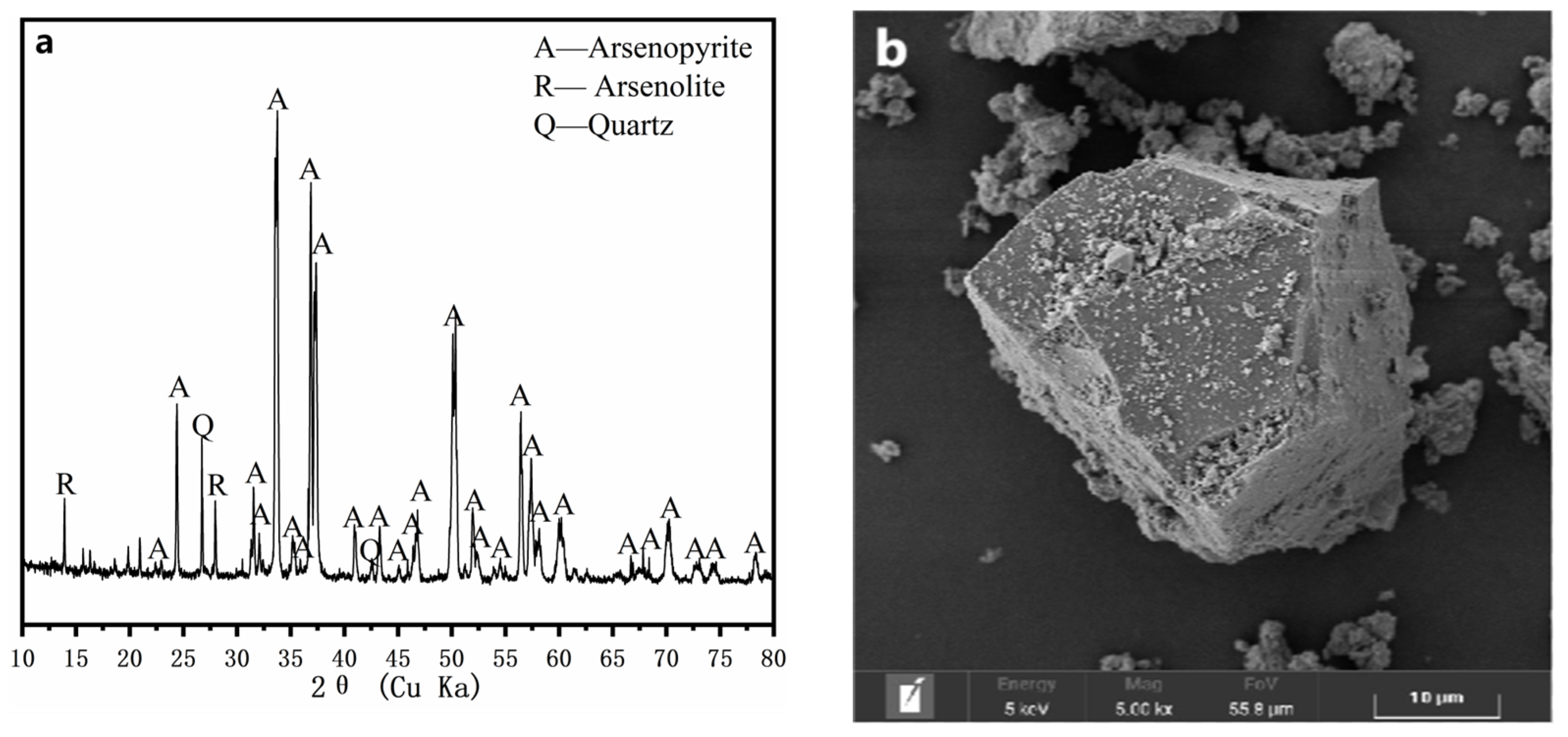


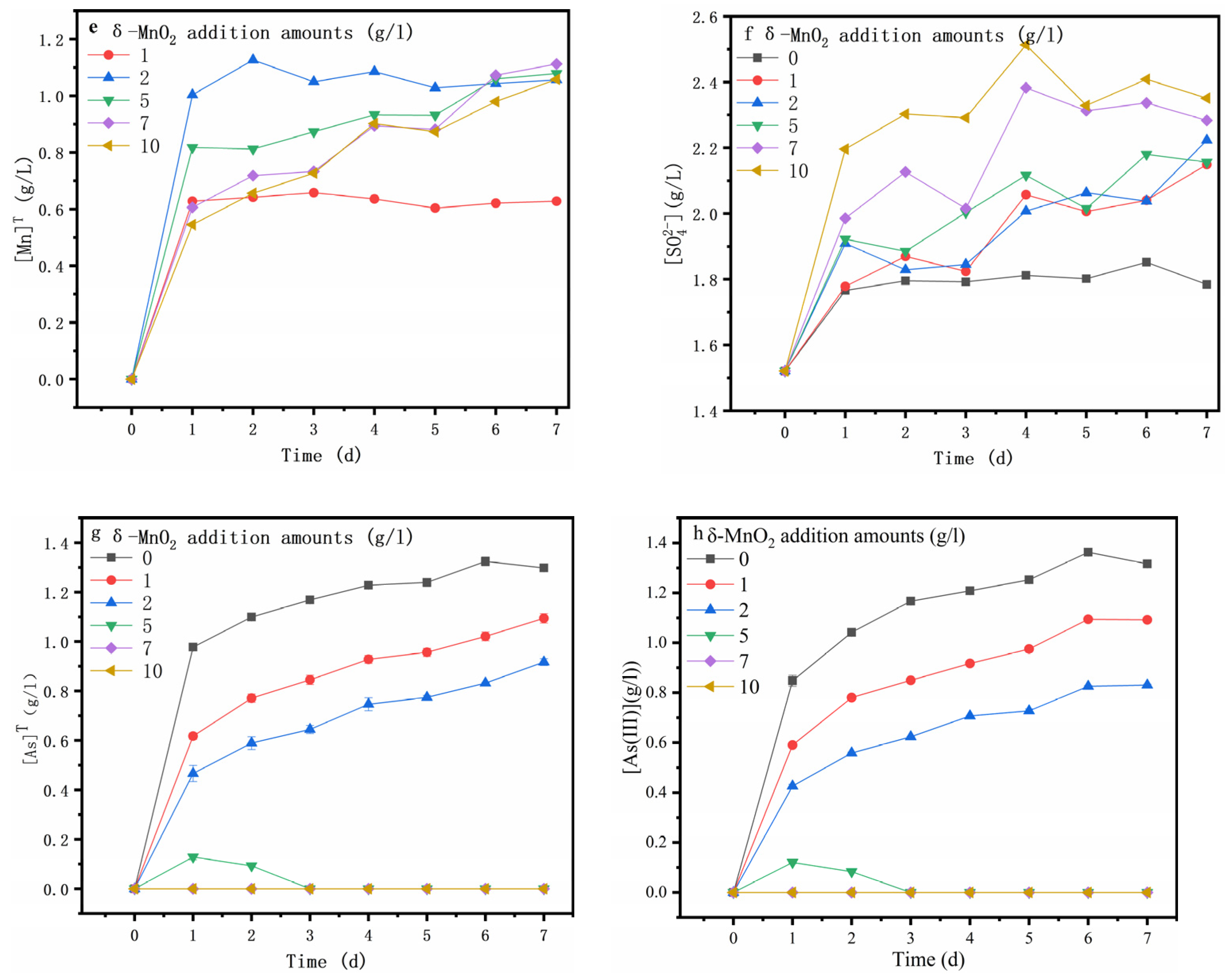


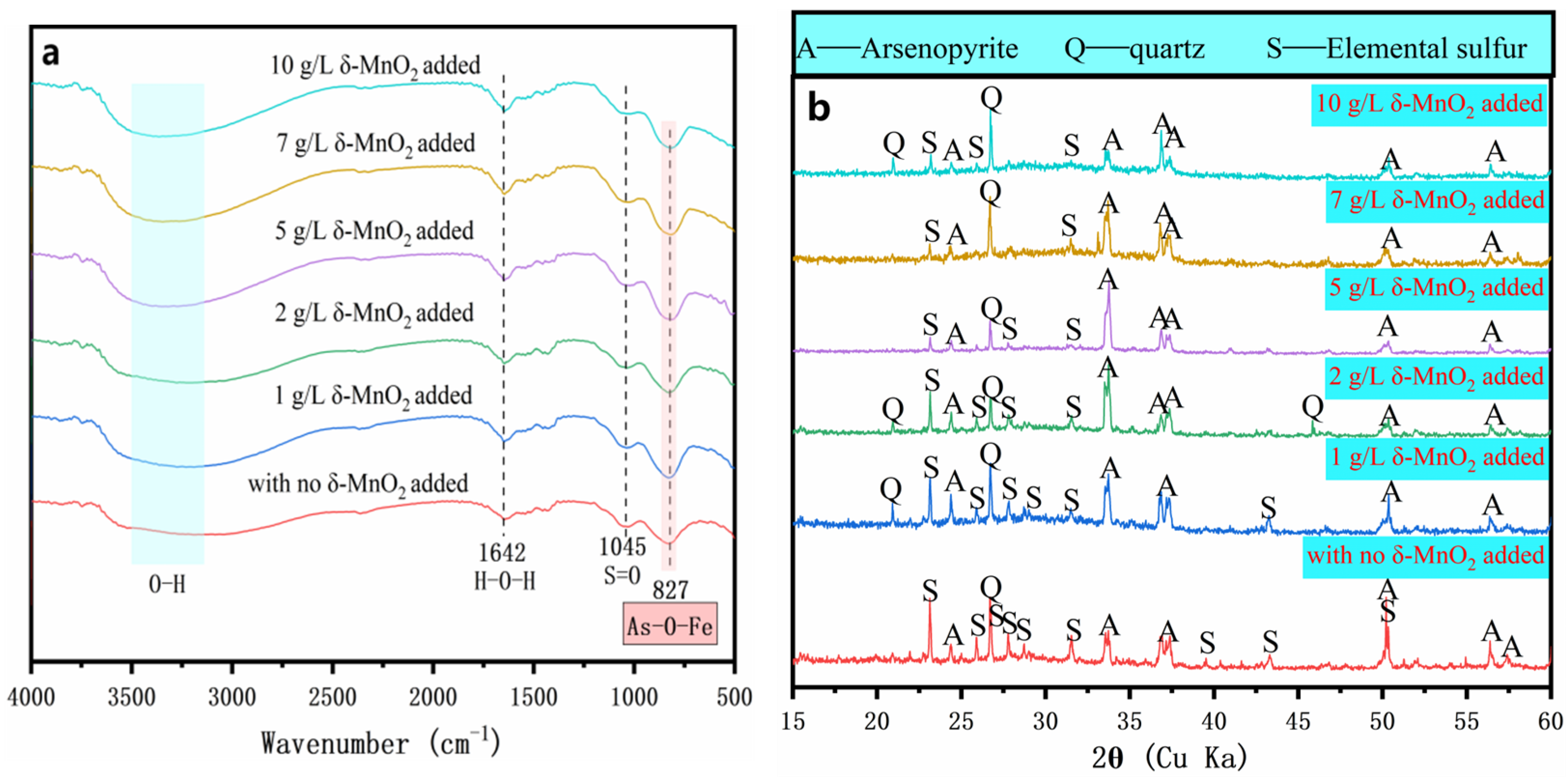
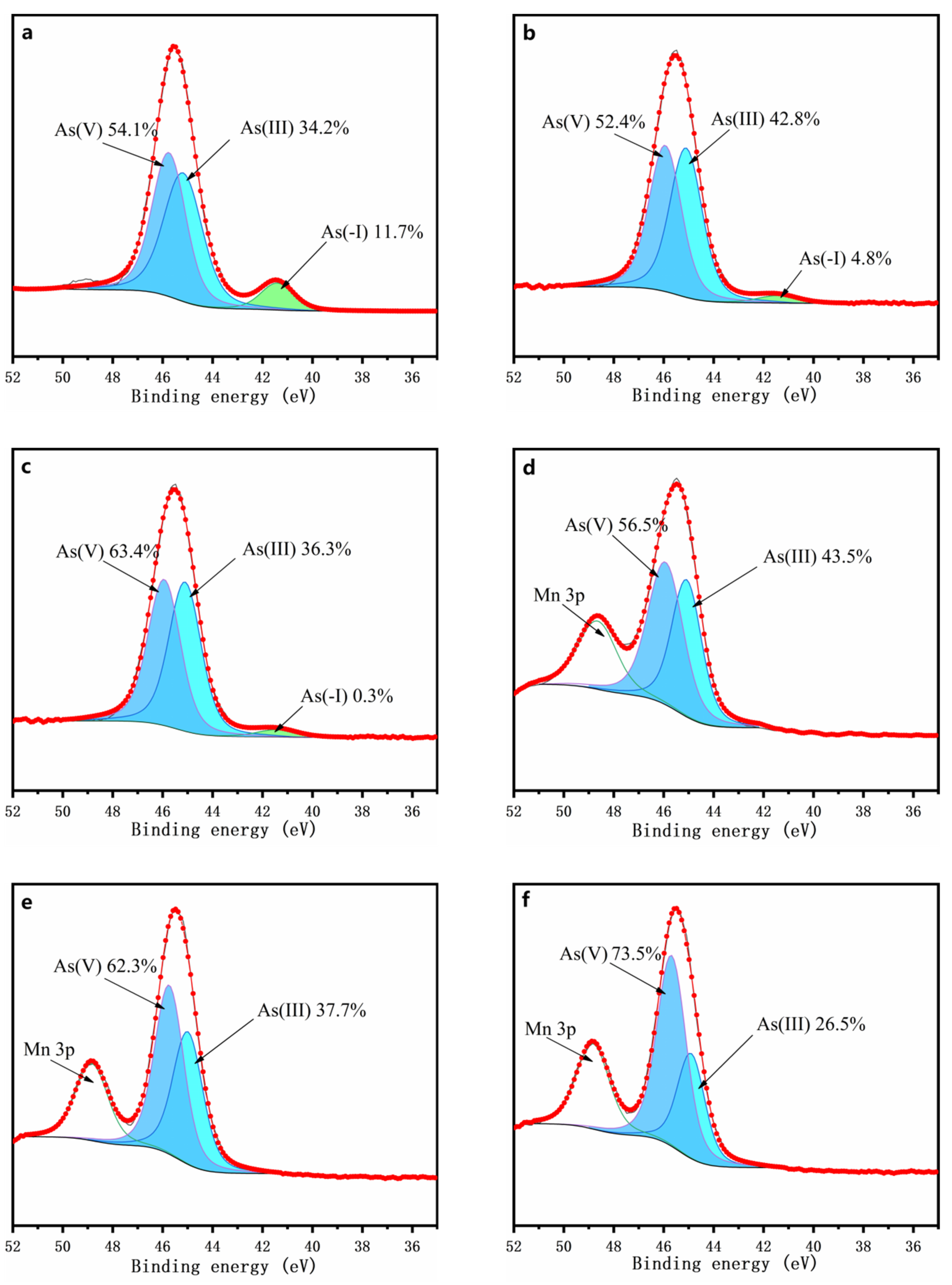

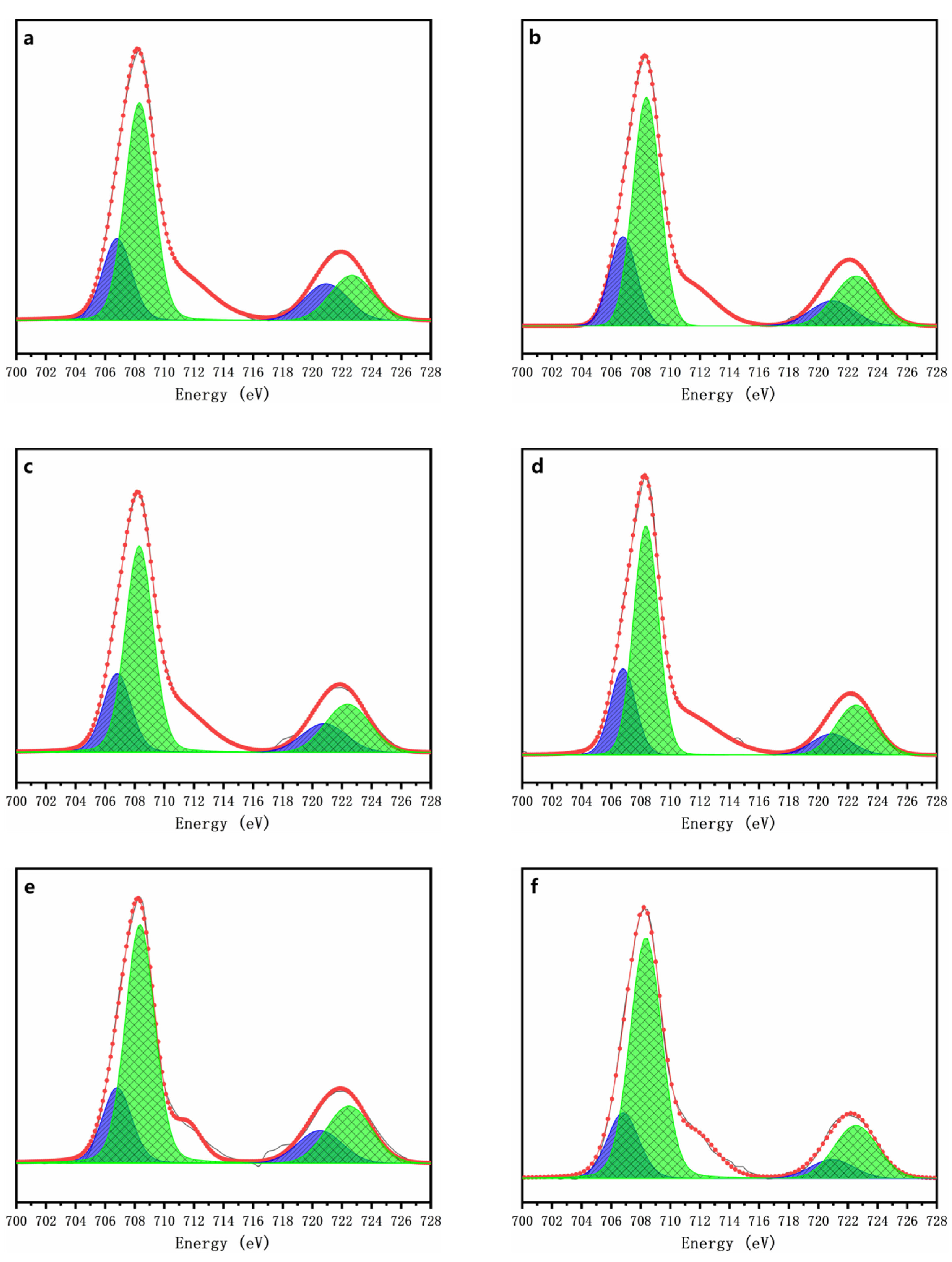
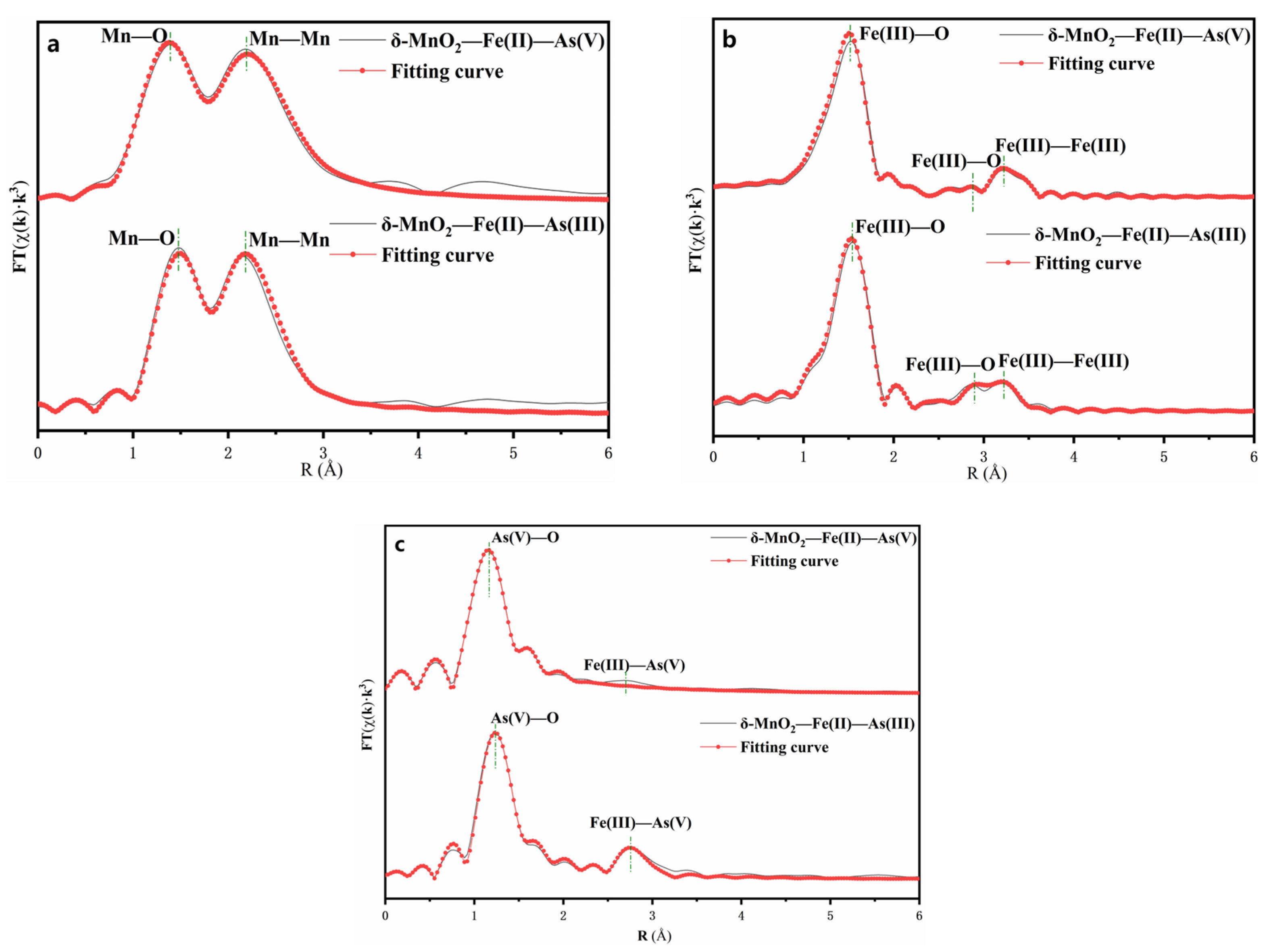
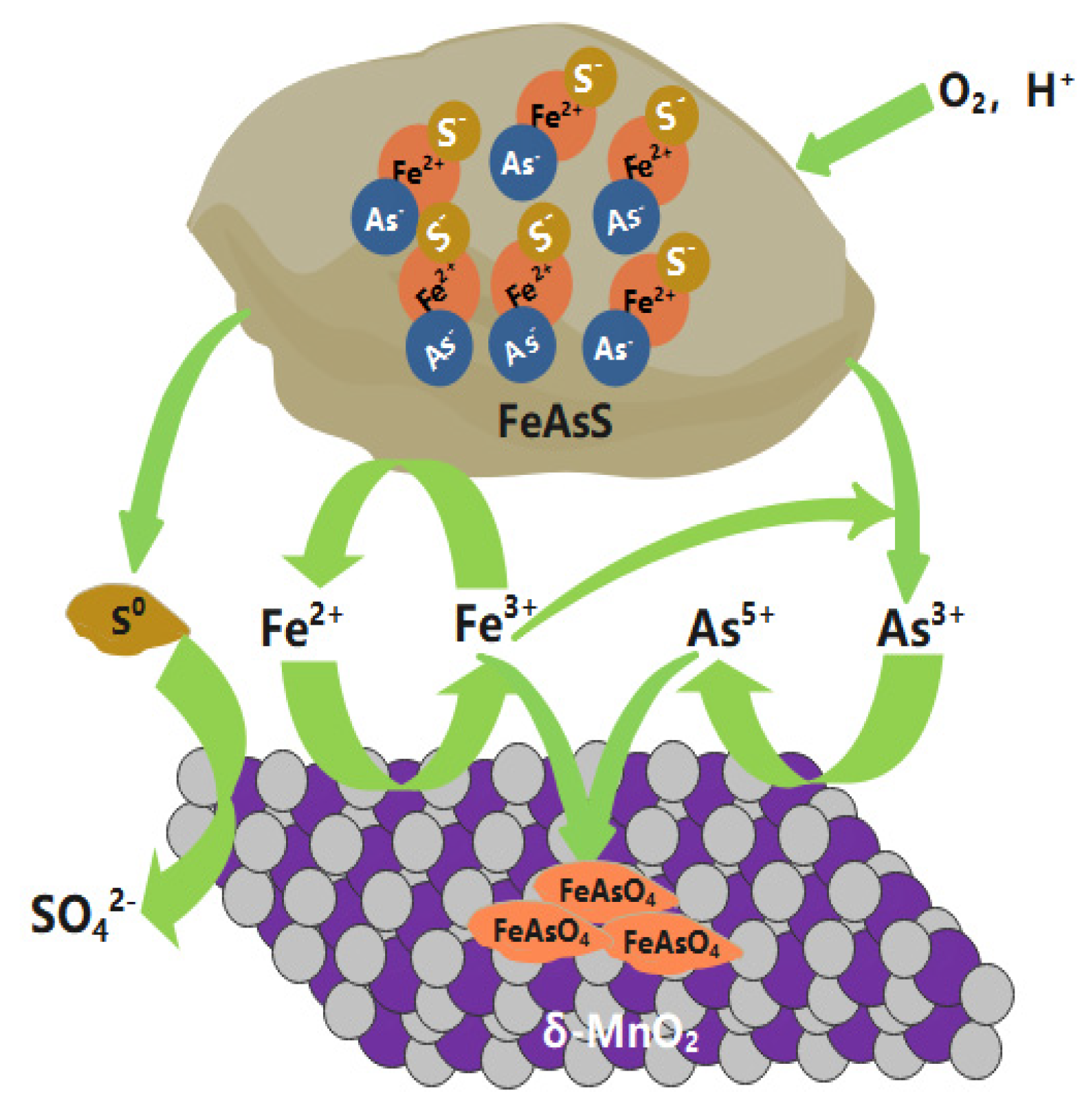
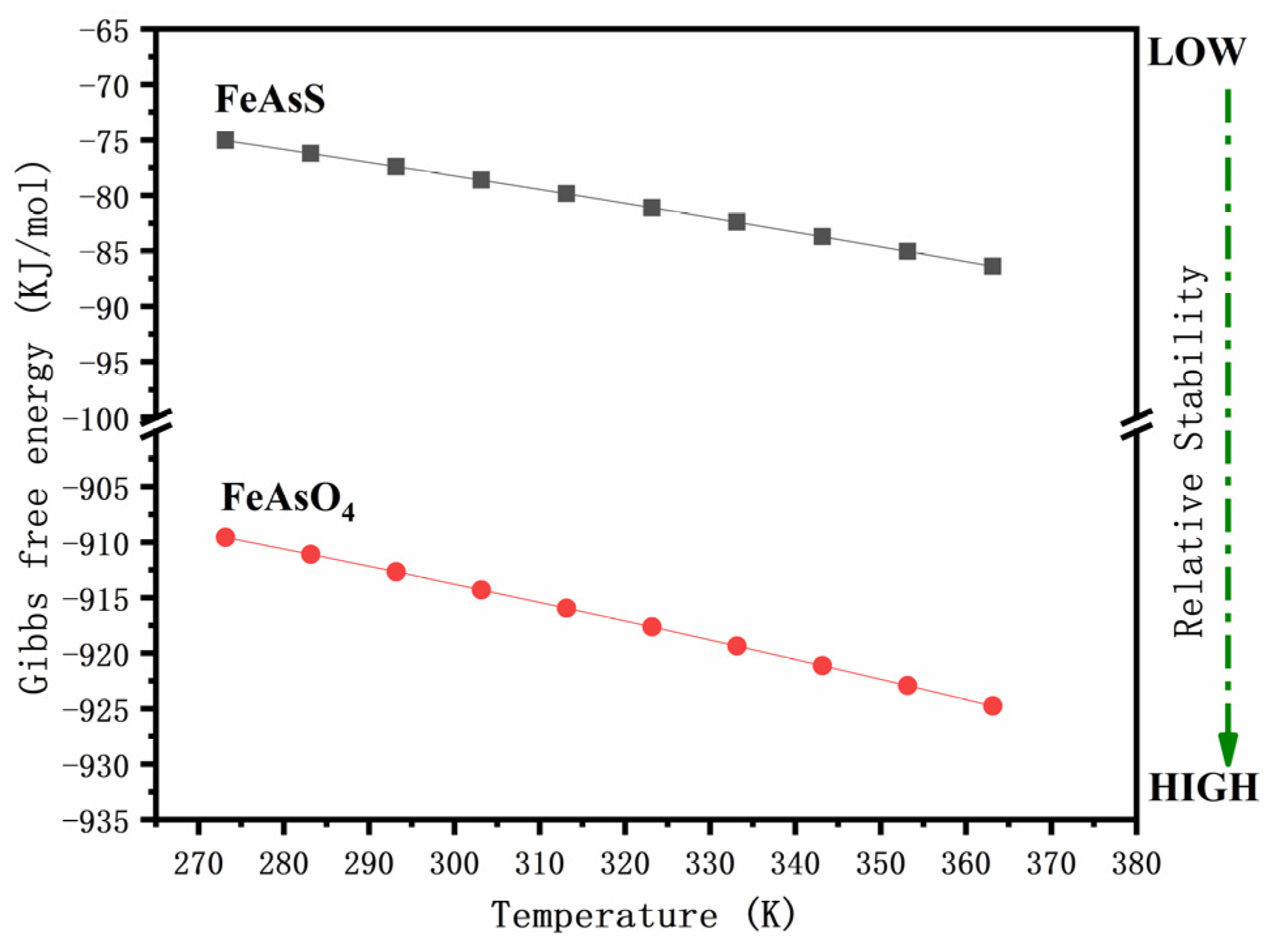
| Samples | Dv(10), μm | Dv(50), μm | Dv(90), μm |
|---|---|---|---|
| Original arsenopyrite | 3.46 | 30.94 | 176.06 |
| 0 | 9.21 | 21.65 | 50.94 |
| 1 | 3.24 | 9.66 | 56.44 |
| 2 | 4.59 | 14.78 | 90.33 |
| 5 | 0.87 | 8.52 | 35.91 |
| 7 | 0.82 | 7.07 | 26.66 |
| 10 | 1.31 | 10.51 | 35.53 |
| Samples | Fe | As | S | Fe/S | Fe/As | As/S |
|---|---|---|---|---|---|---|
| Original arsenopyrite | 25.32 | 36.05 | 38.63 | 0.66 | 0.70 | 0.93 |
| 0 | 26.28 | 43.09 | 30.63 | 0.86 | 0.61 | 1.41 |
| 1 | 34.66 | 48.20 | 17.10 | 0.72 | 0.72 | 2.03 |
| 2 | 26.60 | 42.56 | 30.80 | 0.86 | 0.63 | 1.38 |
| 5 | 24.33 | 61.90 | 13.80 | 1.76 | 0.39 | 4.49 |
| 7 | 28.38 | 59.60 | 12.00 | 2.37 | 0.48 | 4.97 |
| 10 | 26.80 | 61.00 | 12.20 | 2.20 | 0.44 | 5.00 |
| Element | Samples | Path | N | R (Å) | σ2 (Å2) | ΔE0 (eV) | R factor |
|---|---|---|---|---|---|---|---|
| Mn | δ-MnO2–Fe(II)–As(V) | Mn–O | 3.3 | 1.95 | 0.002 | 5.23 | 0.024 |
| Mn–Mn | 3.9 | 2.94 | 0.003 | ||||
| δ-MnO2–Fe(II)–As(III) | Mn–O | 3.1 | 1.95 | 0.001 | 4.78 | 0.018 | |
| Mn–Mn | 3.7 | 2.94 | 0.002 | ||||
| Fe | δ-MnO2–Fe(II)–As(V) | Fe(III)–O | 2.6 | 1.92 | 0.0009 | 6.11 | 0.032 |
| Fe(III)–O | 0.7 | 3.29 | 0.002 | ||||
| Fe(III)–Fe(III) | 0.8 | 3.37 | 0.001 | ||||
| δ-MnO2–Fe(II)–As(III) | Fe(III)–O | 2.6 | 1.92 | 0.001 | 5.47 | 0.027 | |
| Fe(III)–O | 0.7 | 3.27 | 0.003 | ||||
| Fe(III)–Fe(III) | 0.8 | 3.36 | 0.004 | ||||
| As | δ-MnO2–Fe(II)–As(V) | As(V)–O | 3.3 | 1.68 | 0.0008 | 3.94 | 0.019 |
| As(V)–Fe(III) | 2.4 | 3.38 | 0.002 | ||||
| δ-MnO2–Fe(II)–As(III) | As(V)–O | 3.2 | 1.71 | 0.003 | 5.18 | 0.017 | |
| As(V)–Fe(III) | 2.1 | 3.40 | 0.004 |
Disclaimer/Publisher’s Note: The statements, opinions and data contained in all publications are solely those of the individual author(s) and contributor(s) and not of MDPI and/or the editor(s). MDPI and/or the editor(s) disclaim responsibility for any injury to people or property resulting from any ideas, methods, instructions or products referred to in the content. |
© 2023 by the authors. Licensee MDPI, Basel, Switzerland. This article is an open access article distributed under the terms and conditions of the Creative Commons Attribution (CC BY) license (https://creativecommons.org/licenses/by/4.0/).
Share and Cite
Pan, X.; Liu, L.-Z.; Nie, Z.-Y.; Xia, J.-L. δ-MnO2 Drives the Green Decomposition of Arsenopyrite by Mediating the Fate of Arsenic to Generate FeAsO4. Minerals 2023, 13, 657. https://doi.org/10.3390/min13050657
Pan X, Liu L-Z, Nie Z-Y, Xia J-L. δ-MnO2 Drives the Green Decomposition of Arsenopyrite by Mediating the Fate of Arsenic to Generate FeAsO4. Minerals. 2023; 13(5):657. https://doi.org/10.3390/min13050657
Chicago/Turabian StylePan, Xuan, Li-Zhu Liu, Zhen-Yuan Nie, and Jin-Lan Xia. 2023. "δ-MnO2 Drives the Green Decomposition of Arsenopyrite by Mediating the Fate of Arsenic to Generate FeAsO4" Minerals 13, no. 5: 657. https://doi.org/10.3390/min13050657




